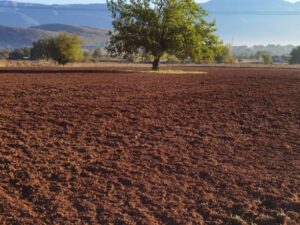
Table of Contents
ToggleIntroduction:
Dryland farming in Indian agriculture holds paramount significance due to its ability to address and overcome various challenges unique to arid and semi-arid regions. These challenges include water scarcity, climate variability, and the need for sustainable agricultural practices. The dimensions of dryland farming encompass a wide array of factors, each playing a crucial role in ensuring the resilience, productivity, and sustainability of agriculture in regions where water resources are limited. Let’s delve deeper into the significance and dimensions of dryland farming in the context of Indian agriculture.
Water Scarcity:
Water scarcity is a pervasive issue in many regions of India, and dryland farming emerges as a vital solution to sustain agriculture in these areas. Traditional irrigated agriculture is often impractical due to the limited availability of water for irrigation. Dryland farming, relying primarily on rainfed agriculture, becomes a lifeline for farmers in regions where water resources are scarce. States like Rajasthan, Gujarat, and parts of Maharashtra, characterized by arid conditions, heavily depend on dryland farming practices to ensure agricultural productivity despite the challenges posed by inadequate water supply.
The significance of dryland farming lies in its capacity to optimize the use of limited water resources efficiently. By harnessing rainwater effectively and employing water conservation techniques, dryland farming allows farmers to cultivate crops without relying on extensive irrigation, making it a sustainable and viable option in water-scarce regions.
Climate Variability:
India experiences diverse climatic conditions, with regions facing unpredictable weather patterns, including erratic rainfall and drought conditions. Dryland farming demonstrates remarkable resilience in the face of climate variability, making it a crucial component of agricultural practices in such regions.
The significance of dryland farming in addressing climate variability is evident in the adaptability of crops grown in these areas. Farmers practicing dryland agriculture choose crops that are well-suited to arid and semi-arid environments, ensuring a more stable agricultural output even when faced with irregular rainfall or prolonged drought periods. This adaptability is essential for sustaining agriculture in the face of unpredictable climate patterns, safeguarding the livelihoods of farmers dependent on rainfed agriculture.
Crop Diversity:
Dryland farming contributes significantly to crop diversification in Indian agriculture. The crops cultivated in arid and semi-arid regions are often different from those grown in irrigated areas, reflecting the adaptability of dryland farming to specific environmental conditions.
Traditional dryland crops include millets, pulses, and oilseeds, which thrive in the arid climate. These crops not only provide food security but also contribute to the overall diversification of the agricultural sector. Moreover, the cultivation of drought-resistant varieties of cereals showcases another dimension of crop diversity within dryland farming. This approach not only mitigates the impact of water scarcity but also enhances the nutritional value of the crops grown in these regions, addressing broader concerns related to food security and health.
Sustainable Agriculture:
Sustainability is a central theme in modern agriculture, and dryland farming aligns well with sustainable practices. The significance of dryland farming in promoting sustainable agriculture is underscored by its emphasis on soil conservation, rainwater harvesting, and moisture retention techniques.
To counter the challenges posed by water scarcity, farmers practicing dryland agriculture implement various sustainable practices. Contour ploughing, agroforestry, and watershed management are some of the techniques employed to conserve soil moisture and prevent soil erosion. These practices not only enhance the sustainability of agriculture in dryland regions but also contribute to the overall health and fertility of the soil, ensuring the long-term productivity of the land.
Livelihood Support:
Dryland farming is a major source of livelihood for millions of farmers in India, particularly in regions where water scarcity prevails. Many small and marginal farmers operate in areas where dryland farming is the primary mode of agriculture, and their livelihoods are intricately linked to the success of rainfed agriculture.
The significance of dryland farming in providing livelihood support is evident in the economic activities and income generation opportunities it creates for these farming communities. Despite the challenges associated with water scarcity and climate variability, the resilience of dryland farming sustains the livelihoods of a significant portion of the rural population in India. It serves as a foundation for rural economies, providing employment opportunities and ensuring the socio-economic well-being of communities in arid and semi-arid regions.
Soil Health and Conservation:
Dryland farming places a strong emphasis on soil health and conservation practices, recognizing the vulnerability of arid and semi-arid soils to erosion and degradation. Soil conservation measures are crucial components of dryland farming, contributing to the overall sustainability of agricultural practices.
Techniques such as mulching, contour bunding, and agroforestry play a pivotal role in preserving soil structure and preventing erosion. Mulching helps retain soil moisture, contour bunding minimizes water runoff, and agroforestry enhances biodiversity while protecting the soil. The dimension of soil health and conservation in dryland farming goes beyond immediate productivity concerns; it is about ensuring the sustainability of agricultural practices and maintaining the long-term viability of the land for future generations.
Research and Development:
Given the dynamic nature of dryland farming, continuous research and development efforts are essential to improve crop varieties, introduce resilient farming practices, and enhance overall productivity. Agricultural universities and research institutions in India actively engage in developing technologies and practices suitable for dryland farming areas.
Researchers focus on breeding drought-resistant crop varieties that can withstand the challenges of arid environments. Optimizing water management techniques, developing climate-resilient farming practices, and identifying new approaches to address the specific challenges faced by farmers in dryland regions are ongoing areas of research. The dimension of research and development underscores the importance of staying abreast of scientific advancements to empower farmers with the knowledge and tools needed to thrive in challenging conditions.
Government Initiatives:
Recognizing the significance of dryland farming, governments at the state and national levels have implemented various schemes and policies to support farming communities in these regions. Government initiatives play a crucial role in creating an enabling environment for farmers practicing dryland agriculture. These initiatives include subsidies for rainwater harvesting structures, promotion of drought-resistant crop varieties, and financial assistance for soil conservation measures.
Government support is instrumental in addressing the financial challenges faced by farmers in adopting sustainable practices. By providing incentives, the government encourages the adoption of technologies and methods that enhance the resilience of dryland farming. These initiatives are not only essential for the immediate well-being of farmers but also contribute to the overall sustainability of agriculture in water-scarce regions.
Conclusion:
In conclusion, the significance and dimensions of dryland farming in Indian agriculture are multi-faceted, addressing critical issues such as water scarcity, climate variability, and sustainable agricultural practices. Dryland farming not only ensures the livelihoods of millions of farmers but also contributes to crop diversification, soil health, and conservation. The ongoing research and government initiatives underscore the commitment to enhancing the productivity and sustainability of dryland farming in India. As the agricultural landscape continues to evolve, the lessons learned from dryland farming practices will likely play a crucial role in shaping resilient and sustainable agricultural systems for the future.

Good
Very good